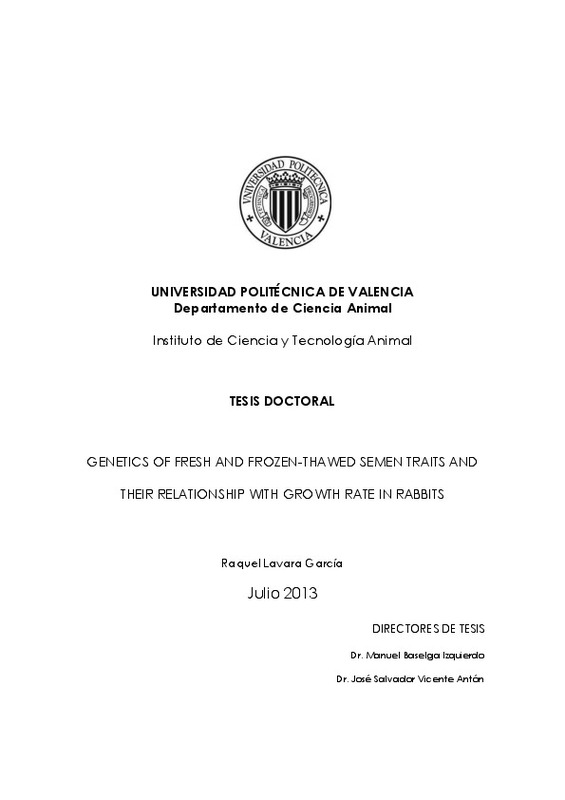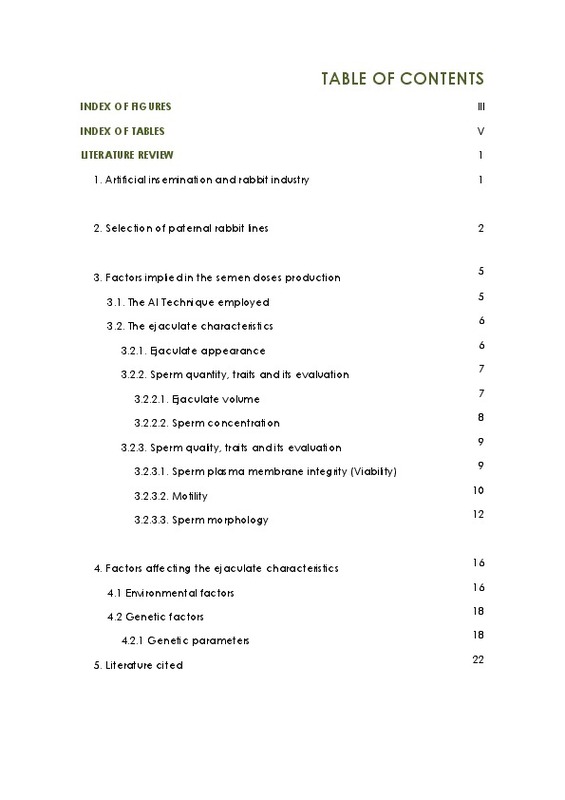- RiuNet repositorio UPV
- :
- Investigación
- :
- Tesis doctorales
- :
- Ver ítem
JavaScript is disabled for your browser. Some features of this site may not work without it.
Buscar en RiuNet
Listar
Mi cuenta
Estadísticas
Ayuda RiuNet
Admin. UPV
Genetics of fresh and frozen-thawed semen traits and their relationship with growth rate in rabbits
Mostrar el registro sencillo del ítem
Ficheros en el ítem
| dc.contributor.advisor | Baselga Izquierdo, Manuel
|
es_ES |
| dc.contributor.advisor | Vicente Antón, José Salvador
|
es_ES |
| dc.contributor.author | Lavara García, Raquel
|
es_ES |
| dc.date.accessioned | 2013-09-02T06:38:40Z | |
| dc.date.available | 2013-09-02T06:38:40Z | |
| dc.date.created | 2013-07-25T10:00:10Z | es_ES |
| dc.date.issued | 2013-09-02T06:38:37Z | es_ES |
| dc.identifier.uri | http://hdl.handle.net/10251/31657 | |
| dc.description.abstract | Se utilizarán eyaculados procedentes de machos de la línea R (línea de conejos seleccionada por velocidad de crecimiento durante el periodo de engorde)alojados en diferentes centros de inseminación artificial. Una vez recuperados los eyaculados se procederá a su valoración y una muestra de todos ellos será crioconservada. La calidad seminal será de nuevo valorada tras el proceso de congelación. Junto con los anàlisis seminales se utilizarán los datos de crecimiento y pedigree de los machos y de todos los animales de la línea R desde su fundación para estimar por un lado los parámetros genéticos de las variables relacionadas con la producción y calidad de dosis seminales en fresco y tras un proceso de crioconservación y la correlación genética existente entre las variables seminales anteriormente citadas y la velocidad de crecimiento. A su vez se estimará mediante un modelo recursivo la relación entre las variables seminales en fresco y tras la descongelación. | es_ES |
| dc.description.abstract | The general aim of this thesis was to study the genetic determinism for some traits related to artificial insemination (AI) dose production of fresh and frozen-thawed semen, in order to explore the interest and limitation of different strategies for their genetic improvement in a paternal line of rabbits selected for growth rate during the fattening period (28-63 days). In chapter 1, genetic parameters of sperm production traits are estimated as well as the genetic relationship with daily gain (DG). The heritabilities (h2) of the semen traits were 0.13±0.05, 0.08±0.04 and 0.07±0.03 for ejaculate volume (V), sperm concentration (CN) and sperm production (PROD) per ejaculate, respectively. A favourable and moderate genetic correlation was observed between V and DG (0.36±0.34). From this chapter it may be concluded that if a seminal trait is to be included as a selection objective, a useful one could be sperm production, as it is a trait in which both volume and concentration are included. Moreover, there is currently no evidence to suggest that selection for DG in rabbits will affect sperm production adversely. The aim of chapter 2 was to explore the genetic determinism of some sperm quality traits and their genetic relation with the selection criteria of the paternal rabbit line. The heritabilities (h2) of semen quality traits commonly evaluated in a classic spermiogram were 0.18, 0.19 and 0.12 for NAR (%, percentage of sperm with intact acrosome), ANR (%, percentage of sperm abnormalities) and MOT (%, percentage of total motile sperm cells) respectively. We also estimated the h2 of some motion CASA parameters 0.09, 0.11, 0.10, 0.11, 0.11 and 0.11 for VAP (µm/s; average path velocity), VSL (µm/s; straight-line velocity), VCL (µm/s; curvilinear velocity), LIN (%, linearity index), ALH (µm; amplitude of the lateral head displacement), STR (%, straightness). Genetic correlations between DG and semen traits showed a high HPD95% (interval of highest density of 95%). However there is some consistent evidence of the negativity of the genetic correlations of DG with NAR and MOT (-0.40 and -0.53, respectively). Chapter 3 aims to determine the repeatability and heritability of sperm head characteristics: width (W, ¿m), area (A, ¿m2),length (L, ¿m) and perimeter (P, ¿m), and explore the relationships between them and with the selection objective (DG). The results obtained showed that sperm head dimensions are heritable (ranged between 0.2 and 0.29). The genetic correlations between sperm traits were always high and positive (between 0.72 and 0.90), with the exception of L-W genetic correlation, which was moderate. Regarding the genetic correlations between DG and sperm head characteristics, the resulting means ranged from -0.09 for L-DG to -0.43 for W-DG, showing consistent evidence of the negativity of the genetic correlations. The environmental and male effects that could have an influence on sperm freezability are studied in Chapter 4. Six different traits were evaluated: sperm concentration (CONC, 106spermatozoa/mL), acrosome integrity in fresh (NAR, %) and frozen-thawed semen (Nar-FT, %), sperm motility in fresh (MOT, %) and frozen-thawed semen (Mot-FT, %) and the percentage of viable sperm in frozen-thawed semen (Live-FT, %). In addition, two synthetic traits were computed: the relative reduction of acrosome integrity (Rnar, %) and relative reduction of motility (Rmot, %) after the freezing-thawing process. A multiple-trait recursive model was used to analyse the relationships between the semen traits considered. For the fixed effects studied, the season had the highest impact on post-thaw semen characteristics. Results of the analysis of recursive coefficients showed that fresh semen concentration and motility influence the future freezability of the semen. All traits studied presented moderate repeatabilities, ranging from 0.11 to 0.38. These results provide conclusive evidence that sperm freezability in rabbits could be heritable. Regarding male correlations, there were large positive male correlations between fresh traits (rm=0.77-0.57), as well as between direct frozen-thawed traits (rm=0.72-1). Male effects on fresh and direct frozen-thawed traits were generally positively correlated. This correlation was moderate to high for MOT with all frozen-thawed traits (rm=0.41-0.74) and for Mot-FT and all fresh traits (rm=0.5-0.74); these results suggest that these traits could be genetically related. The final chapter of this thesis focused on estimating the heritability of semen freezability traits and estimating the genetic correlation between frozen-thawed sperm traits and the growth rate in a paternal rabbit line. Estimated heritabilities showed that frozen-thawed semen traits are heritable (ranged between 0.08 and 0.15). In the case of Live-FT, the estimated heritability is the highest and suggests the possibility of effective selection. After the study of genetic correlations, it seems that DG was negatively correlated with sperm freezability, but due to the high HPD95% no further conclusions could be drawn. More data should be included in order to obtain better accuracy for the estimates of these genetic correlations. If the results obtained in the present study were confirmed, it would imply that selection for DG could alter sperm cell membranes or seminal plasma composition, both components related to sperm cryoresistance. | en_EN |
| dc.language | Inglés | es_ES |
| dc.publisher | Universitat Politècnica de València | es_ES |
| dc.rights | Reserva de todos los derechos | es_ES |
| dc.source | Riunet | es_ES |
| dc.subject | Rabbit | es_ES |
| dc.subject | Semen | es_ES |
| dc.subject | Artificial insemination | es_ES |
| dc.subject | Heritability | es_ES |
| dc.subject | Genetic correlation | es_ES |
| dc.subject | Semen freezabilit | es_ES |
| dc.subject.classification | PRODUCCION ANIMAL | es_ES |
| dc.title | Genetics of fresh and frozen-thawed semen traits and their relationship with growth rate in rabbits | |
| dc.type | Tesis doctoral | es_ES |
| dc.identifier.doi | 10.4995/Thesis/10251/31657 | es_ES |
| dc.rights.accessRights | Abierto | es_ES |
| dc.contributor.affiliation | Universitat Politècnica de València. Departamento de Ciencia Animal - Departament de Ciència Animal | es_ES |
| dc.description.bibliographicCitation | Lavara García, R. (2013). Genetics of fresh and frozen-thawed semen traits and their relationship with growth rate in rabbits [Tesis doctoral]. Universitat Politècnica de València. https://doi.org/10.4995/Thesis/10251/31657 | es_ES |
| dc.description.accrualMethod | TESIS | es_ES |
| dc.type.version | info:eu-repo/semantics/acceptedVersion | es_ES |
| dc.relation.tesis | 4229 | es_ES |
Este ítem aparece en la(s) siguiente(s) colección(ones)
-
Tesis doctorales [5399]







![MS Word file [Word]](/themes/UPV/images/msword.png)


